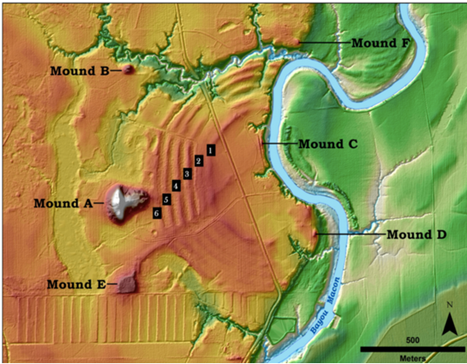
America’s first civilization was made up of ‘sophisticated’ engineers
Native Americans that occupied an area known as Poverty Point in northern Louisiana more than 3,000 years ago were highly skilled engineers capable of building massive earthen structures in a matter of months — possibly even weeks — that withstood the test of time.
According to Tristram R. “T.R.” Kidder, lead author and the Edward S. and Tedi Macias Professor of Anthropology in Arts & Sciences. “One of the most remarkable things is that these earthworks have held together for more than 3,000 years with no failure or major erosion. By comparison, modern bridges, highways and dams fail with amazing regularity because building things out of dirt is more complicated than you would think. They really were incredible engineers with very sophisticated technical knowledge.” The results were recently published in Southeastern Archaeology.
The Poverty Point World Heritage site consists of a massive 72-foot-tall earthen mound and concentric half circle ridges constructed by hunter-gatherers approximately 3,400 years ago from nearly 2 million cubic yards of soil. They did not have the luxury of modern tools, domesticated animals or even wheeled carts.
According to Kidder, the site was likely an important religious site where Native Americans came in pilgrimage, similar to Mecca. It was abandoned abruptly between 3,000-3,200 years ago – most likely due to documented flooding in the Mississippi Valley and climate change. Kidder and team re-excavated and re-evaluated a site on Ridge West 3 at the Poverty Point Site that was originally excavated by renowned archaeologist Jon Gibson in 1991.
The research provides conclusive evidence that the earthworks were built rapidly. There is no evidence of boundaries or signs of weathering between the various levels. Kidder believes the construction was completed in lifts, or layers of sediment deposited to increase the ridge height and linear dimensions before another layer was placed to expand the footprint vertically and horizontally. These findings challenge previous beliefs about how pre-modern hunters and gatherers behaved. Building the enormous mounds and ridges at Poverty Point would have required a large labor pool that was well organized and would have required leadership to execute. Hunters and gathers were believed to shun politics.
Due to its proximity to the Gulf of Mexico, this area receives immense amounts of rain that makes earthworks especially prone to erosion. Microscopic analysis of soils shows that the Native Americans mixed different types of soil — clays, silts and sand — in a calculated recipe to make the structures stronger.
Original Release: Eureka Alert
